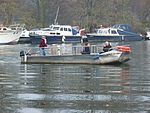St Stephen's, Twickenham

St Stephen's, Twickenham, is a Church of England church on Richmond Road in East Twickenham in the London Borough of Richmond upon Thames. Its vicar is Jez Barnes.The congregation dates from 1720 when a chapel was founded on what was to become Montpelier Road.The building, which dates from 1874 and is Grade II listed, was designed by T. M. Lockwood and T. H. Mawson. The chancel was added in 1885 and the tower in 1907. Most of the stained glass windows are by Alfred Octavius Hemming (1843–1907). The organ, installed in 1889, is one of the best preserved Henry Willis & Sons organs in London.Services are held on Sunday mornings at 9.00 am, 10.30 am and 6.00 pm.St. Stephen's School, Twickenham, a mixed, state-run, Church of England primary school on Winchester Road, is affiliated with St Stephen's Church and regularly holds events there.
Excerpt from the Wikipedia article St Stephen's, Twickenham (License: CC BY-SA 3.0, Authors, Images).St Stephen's, Twickenham
Richmond Road, London Twickenham (London Borough of Richmond upon Thames)
Geographical coordinates (GPS) Address Phone number Website External links Nearby Places Show on map
Geographical coordinates (GPS)
| Latitude | Longitude |
|---|---|
| N 51.4534 ° | E -0.31304 ° |
Address
St Stephen's
Richmond Road
TW1 2PD London, Twickenham (London Borough of Richmond upon Thames)
England, United Kingdom
Open on Google Maps










